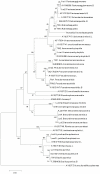Identification of the midgut microbiota of An. stephensi and An. maculipennis for their application as a paratransgenic tool against malaria
- PMID: 22163022
- PMCID: PMC3232223
- DOI: 10.1371/journal.pone.0028484
Identification of the midgut microbiota of An. stephensi and An. maculipennis for their application as a paratransgenic tool against malaria
Abstract
The midgut microbiota associated with Anopheles stephensi and Anopheles maculipennis (Diptera: Culicidae) was investigated for development of a paratransgenesis-based approach to control malaria transmission in Eastern Mediterranean Region (EMR). Here, we present the results of a polymerase chain reaction (PCR) and biochemical-based approaches to identify the female adult and larvae mosquitoe microbiota of these two major malaria vectors, originated from South Eastern and North of Iran. Plating the mosquito midgut contents from lab-reared and field-collected Anopheles spp. was used for microbiota isolation. The gram-negative and gram-positive bacterial colonies were identified by Gram staining and specific mediums. Selected colonies were identified by differential biochemical tests and 16S rRNA gene sequence analysis. A number of 10 An. stephensi and 32 An. maculipennis adult mosquitoes and 15 An. stephensi and 7 An. maculipennis larvae were analyzed and 13 sequences of 16S rRNA gene bacterial species were retrieved, that were categorized in 3 classes and 8 families. The majority of the identified bacteria were belonged to the γ-proteobacteria class, including Pseudomonas sp. and Aeromonas sp. and the others were some closely related to those found in other vector mosquitoes, including Pantoea, Acinetobacter, Brevundimonas, Bacillus, Sphingomonas, Lysinibacillus and Rahnella. The 16S rRNA sequences in the current study aligned with the reference strains available in GenBank were used for construction of the phylogenetic tree that revealed the relatedness among the bacteria identified. The presented data strongly encourage further investigations, to verify the potential role of the detected bacteria for the malaria control in Iran and neighboring countries.
Conflict of interest statement
Figures


References
-
- Beard CB, Cordon-Rosales C, Durvasula RV. Bacterial symbionts of the triatominae and their potential use in control of Chagas disease transmission. Annu Rev Entomol. 2002;47:123–141. - PubMed
Publication types
MeSH terms
Substances
LinkOut - more resources
Full Text Sources
Medical
Miscellaneous

